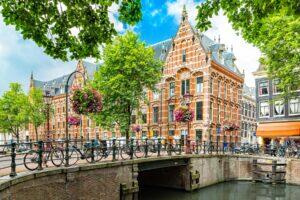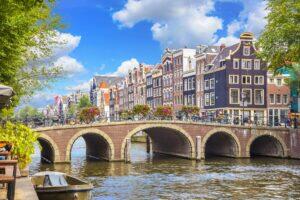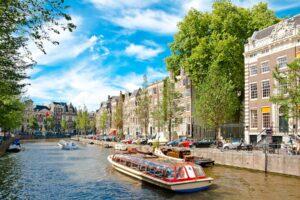Fodor's Expert Review Het Scheepvaartmuseum
Designed by Daniël Stalpaert in 1656 as an arsenal for the Admiralty of Amsterdam, this excellent example of Dutch Classicism became the new home of the Maritime Museum in the 1970s. Even if you're not much of a nautical fan, the building alone is worth a visit. The courtyard (free) of the biggest remaining 17th-century arsenal was roofed over with a 200,000-kg (440,925-pound) glass-and-steel construction, the design of which is a reference to wind roses and compass lines on old nautical charts. In the daytime, the roof casts ever-changing shadows on the courtyard floor (weather permitting); at night, hundreds of LED lights on the rafters create the fairy-tale illusion of a star-spangled sky.
The museum itself has one-room exhibitions, each with a different theme. The East wing houses an impressive collection of maritime objects, with paintings (the pen drawings by 17th-century master marine painters Ludolf Backhuysen and Willem van de Velde the Elder are particularly... READ MORE
Designed by Daniël Stalpaert in 1656 as an arsenal for the Admiralty of Amsterdam, this excellent example of Dutch Classicism became the new home of the Maritime Museum in the 1970s. Even if you're not much of a nautical fan, the building alone is worth a visit. The courtyard (free) of the biggest remaining 17th-century arsenal was roofed over with a 200,000-kg (440,925-pound) glass-and-steel construction, the design of which is a reference to wind roses and compass lines on old nautical charts. In the daytime, the roof casts ever-changing shadows on the courtyard floor (weather permitting); at night, hundreds of LED lights on the rafters create the fairy-tale illusion of a star-spangled sky.
The museum itself has one-room exhibitions, each with a different theme. The East wing houses an impressive collection of maritime objects, with paintings (the pen drawings by 17th-century master marine painters Ludolf Backhuysen and Willem van de Velde the Elder are particularly beautiful), one of the most important globe collections in the world, nautical instruments, yacht models, and all sorts of symbolic ship decorations. Moored on the jetty outside is the Scheepvaartmuseum’s biggest draw: a life-size replica of a 1748 ship of the Dutch East India Company (VOC). The original left for Asia shortly after it was built, but wrecked off the English coast. Exploring the ship while trying to imagine how people were able to live here for months on end is fascinating.
READ LESS








